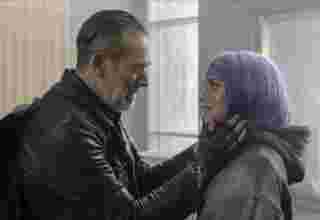
Fans of all things Batman are mighty confused lately. In the weeks since the official news that James Gunn and Peter Safran were named Co-Chairmen and Chief Executive Officers of DC Studios, the full shape of what we once knew as the DCEU remains unknown. The recent reports that Gunn and Safran have apparently axed the mooted Batman Beyond film is a blow to fans excited for Michael Keaton’s return to don the cowl and have been primed for more. Coming hot on the heels of the surprise cancelation of the Batgirl feature, these developments have left a lot of Bat-fans scratching their heads.
In this era of cinematic universes both profitable (the MCU) and abortive (the Dark Universe, anyone?), the DC(E)U has had a notoriously rocky run. With the original continuity established by Zack Snyder’s Man of Steel and Batman V Superman: Dawn of Justice now upended, the role Batman will play in the 10-year plan Gunn and Safran now manage remains murky at best. Matt Reeves’ The Batman was a huge success, with Robert Pattinson’s incarnation of the Dark Knight a hit with fans and critics alike. Reeves’ long-term DC projects appear to be safe, as does Todd Phillips’ hit Joker continuity, but we still don’t know which Batman will be considered the “prime” Batman of the new DCU.
Warner Bros. Discovery CEO David Zaslav telegraphed the changes coming to the DCU when he stated: “there’s not going to be four Batmans.” Zaslav, Gunn, and Safran understandably want to focus on a universe of their own making, and the success of The Batman makes its continuity a logical choice. Still, if one of Warner/DC’s goals is to distinguish this gestating cinematic universe from the MCU, this decision counts as a missed opportunity.
Why Can’t We Have Four Batmen?
There have always been multiple versions of characters like Batman in the comic books. As I write this, the ongoing comic series featuring the character’s universe includes Batman: Urban Legends, I Am Batman, Batgirls, Tim Drake: Robin, and Batman, Incorporated. Some recent standout multiversal spins on Batman are The Batman Who Laughs, centered on a dark(er), alternate-reality version of Bruce Wayne who merged with the Joker to become the insane titular supervillain, and Batman: White Knight, which follows a seemingly “cured” Joker who becomes a politician and sets out to save the city from Batman.
Within this expected context for the character, why can’t we have four Batmans? There is a valid argument that this approach could dilute the Batman IP and diminish its commercial prospects, but I contend that the opposite is true. With Batman perhaps more than any other major superhero character, fans are used to seeing a new actor don the cape and cowl every few years. Committing to more than one cinematic Bat universe would be true to the spirit of the character’s origins.
And after all, we already have three established Batmen fresh in our collective recent memory: Robert Pattinson, Ben Affleck’s under-appreciated turn in the now-abandoned Snyderverse, and Michael Keaton. With smart, savvy marketing and plenty of room between released dates, the rumored Keaton solo film, the sequel to The Batman, and even Affleck’s possible directing entry (which probably won’t feature him as Batman… but it should) can co-exist, and be successful.
Beyond the multiple possible continuities — and by extension, multiple Bat-franchises — embracing a multiverse would distinguish the DCU from its biggest competitor.
What Is Marvel NOT Doing?
In an alternate dimension not far removed from ours, 2005’s Batman Begins and 2006’s Superman Returns kicked off DC’s cinematic universe, getting the jump on Marvel Studios by a couple of years. This did not happen, of course, and in 2012, the MCU’s Phase 1 culminated in the massive success of The Avengers, while DC and Warner Bros. faced the end of Christopher Nolan’s Bat-trilogy with The Dark Knight Rises. All of this arguably amounted to a missed opportunity, as well. Bat-fans are not sorry Nolan’s films exist, but allowing Christian Bale’s Batman to be the only superhero of that universe put DC firmly behind the eight-ball.
The year 2023 marks fifteen years of the MCU, a mostly-consistent narrative universe spread out across films, television, and streaming content. The overall bright, punchy tone of Marvel movies in general evokes the spirit of Marvel Comics and serve as a distinct contrast from the gloomier tone of much of the DCEU (the colorful, upbeat tones of Shazam and Aquaman are the big exceptions here). Until recently, however, the one aspect of the comics that the MCU has not emulated is a lean into the multiverse of it all. Loki, What If…?, the final two entries of the MCU’s Spider-Man trilogy, and Doctor Strange in the Multiverse of Madness find Marvel finally wading into an ocean of parallel realities.
Still, by the end of each of these titles, the possibility that a permanent opening into these realities might remain viable has been pruned back. We can safely assume that, say, the casting of John Krasinski as Reed Richards aka Mr. Fantastic in Multiverse of Madness was a winking, self-aware one-off. Also, given Daredevil’s red and gold costume in She-Hulk, it is entirely likely that the character’s darker, more violent Netflix adventures are all part of a different universe as well. Marvel seems unwilling to truly let loose like it arguably should. Fans hoping to see Tom Cruise as a multiversal Tony Stark shouldn’t hold their breath.
Committing to multiple Bat-properties at once — while teasing more potential crossovers — would stake out territory that Marvel seems unwilling to explore at the moment. The studio could even tap into other Elseworlds-style continuities, too, including Nolan’s universe or that of TV’s Batwoman. After all, as we’ve established, there are many different Bat-stories that can run concurrently.
Who is… Batman?

This is Jim Carrey’s Riddler from Batman Forever talking, not me. For each of the big-and-small screen faces who have played the character — Adam West, Keaton, Val Kilmer, George Clooney, Bale, Affleck, Pattinson — we get a slightly different version of a very familiar tune. From the cheerful Caped Crusader from camp-tastic ’60s TV show to Pattinson’s mega-brooding, Kurt Cobain-inspired incarnation, each actor in each entry brings a new dimension to the Dark Knight. Some are obviously more memorable than others, but fans can always expect something different.
What if we had a Batman Beyond series following an aging Bruce Wayne as he trains a newcomer to don the cowl? Concurrently, we follow Affleck’s middle-aged Dark Knight as he navigates a revamped version of the Snyderverse. Meanwhile, The Penguin series on HBO Max spawns other limited series fleshing out Matt Reeves’ fascinating, expansive Gotham City in between feature installments. These are just the known possible Bats we can conjecture about; who knows what Gunn and Safran plan to introduce?
A multiverse of Batmen means an array of storytelling possibilities. This is all amounts to little more than fantasy fan-casting, but that doesn’t change the unique opportunity DC and Warner Bros. have at hand. We could watch many different versions of Batman at once, with different aspects of the character continuously on display. Could they all intersect? Could Joaquin Phoenix’s Joker cross paths with Barry Keoghan’s Clown Price of Crime? Could Lady Gaga’s upcoming Harley Quinn tangle with Margot Robbie’s fan-favorite take on the Joker’s moll? Of course, they could — that’s the wonder and magic of a comic book, after all. What if, just once, fans got the hero they want and deserve?
[via]







